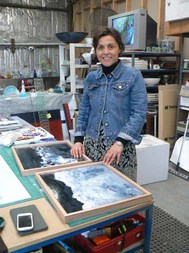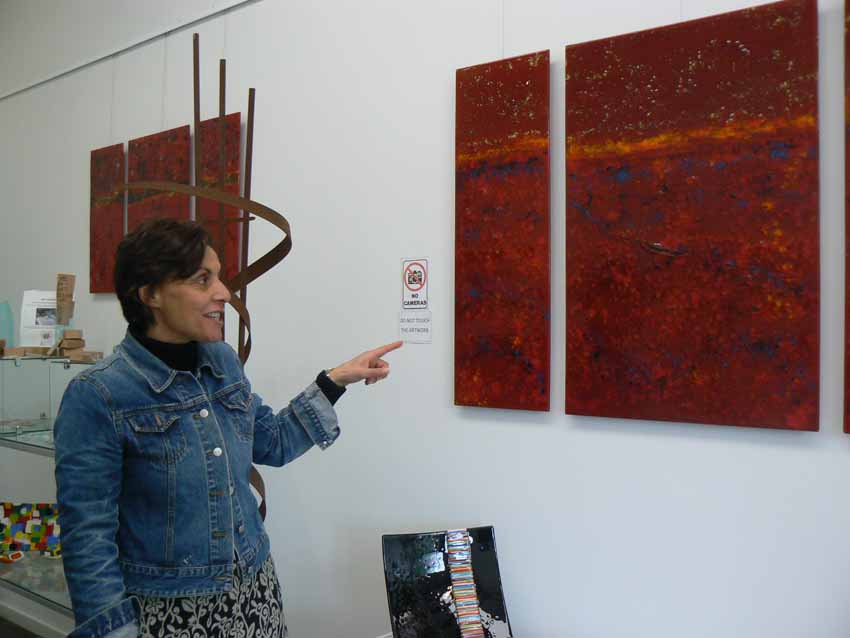
Marlene Abela worked in finance before realising her medium was glass, not money.
By Liane Arno
I HAD always understood that there were left-brained people whose brains were associated with linear and analytical thought, who are logical and objective and are great engineers, people I frankly thought of as “cone heads”. Then there were the right-brained people who were the creative ones filled with the artistic ability to make us experience joy and sadness and all the emotions as we view their work.
So – when I look at the work of Marlene Abela filled with colour and movement I am convinced that she must be a right-brained person. And yet Marlene’s first career was in the banking industry. It’s a strange entry into a life of art through a career concentrating on numbers.
As the youngest of four, she had the joy of being able to spend time with her father, a pastry chef by trade. As she held his hand as they walked together, he instilled in her the importance of a work ethic. She was brought up to believe that if you really want something you need to work for it. She married young and their first house was a small dark Victorian place into which she wanted to add light – and so she undertook a lead lighting course and filled her home with colour. That was when Marlene fell in love with glass.
She left her finance career and started work in the music industry; it was in the days of the sound booths where you could listen to the CDs that were ordered from huge catalogues. There was certainly no internet or Google to aid in the search process. After seven years, she decided it was time to move back into the finance industry to pursue a more financially secure job. But she hated dealing with money. She wasn’t flippant about the need for money but found it overruled other significant and relevant needs in life. Her dissatisfaction with her career grew. After another seven years of working in an industry that bored her to death, she opted out and, along with her husband, Andrew, sold up everything for a life in art.
Marlene Abela has had a long love affair with glass.
Their art practice began in the Artfusion Gallery in Thompson Avenue, Cowes, then due to family commitments they moved to Sandy Point, which was always to be a weekender but then became their home and their escape. Marlene built a beautiful studio and had a kiln built for her that would meet her needs and here she became an experimental artist, learning as she went. Inspired by her love of glass, remembering her early childhood filled with chandeliers and beautiful ornamental glass vases, Marlene attended the workshops of international artists visiting Australia.
She left behind the dirt and mess of working with lead lighting and explored techniques and processes such as screen printing on glass or blending colours and casting glass. She has explored imagery on glass including lithographs and photographs – all of them stunning. Three years ago Artfusion Gallery moved to Anderson Rise in Anderson. It is now Artfusion Studio and Gallery, two studios and a retail space. It is here that Marlene works in the glass studio, developing her craft and growing as a maker, alongside Andrew, who works as a steel sculptor in the steel studio. They look forward to a life filled with making art together.
As I interviewed Marlene, she perched on a very functional stool liberally sprinkled with paint splotches. She told me it had been with her for many years – her mother gave it to her as an engagement present and it brings back fond memories of years sitting on a very similar stool around the kitchen table in her family home filled with relatives.
Marlene’s latest work is a new series titled “Storm” that she will exhibit at the Derinya Art & Craft Exhibition, at the Derinya Primary School, Overport Road, Frankston South, on the weekend of July 18-19. You can always find her work at ArtSpace Wonthaggi, as well as at her own space, the Artfusion Studio and Gallery, near the Anderson roundabout.
I HAD always understood that there were left-brained people whose brains were associated with linear and analytical thought, who are logical and objective and are great engineers, people I frankly thought of as “cone heads”. Then there were the right-brained people who were the creative ones filled with the artistic ability to make us experience joy and sadness and all the emotions as we view their work.
So – when I look at the work of Marlene Abela filled with colour and movement I am convinced that she must be a right-brained person. And yet Marlene’s first career was in the banking industry. It’s a strange entry into a life of art through a career concentrating on numbers.
As the youngest of four, she had the joy of being able to spend time with her father, a pastry chef by trade. As she held his hand as they walked together, he instilled in her the importance of a work ethic. She was brought up to believe that if you really want something you need to work for it. She married young and their first house was a small dark Victorian place into which she wanted to add light – and so she undertook a lead lighting course and filled her home with colour. That was when Marlene fell in love with glass.
She left her finance career and started work in the music industry; it was in the days of the sound booths where you could listen to the CDs that were ordered from huge catalogues. There was certainly no internet or Google to aid in the search process. After seven years, she decided it was time to move back into the finance industry to pursue a more financially secure job. But she hated dealing with money. She wasn’t flippant about the need for money but found it overruled other significant and relevant needs in life. Her dissatisfaction with her career grew. After another seven years of working in an industry that bored her to death, she opted out and, along with her husband, Andrew, sold up everything for a life in art.
Marlene Abela has had a long love affair with glass.
Their art practice began in the Artfusion Gallery in Thompson Avenue, Cowes, then due to family commitments they moved to Sandy Point, which was always to be a weekender but then became their home and their escape. Marlene built a beautiful studio and had a kiln built for her that would meet her needs and here she became an experimental artist, learning as she went. Inspired by her love of glass, remembering her early childhood filled with chandeliers and beautiful ornamental glass vases, Marlene attended the workshops of international artists visiting Australia.
She left behind the dirt and mess of working with lead lighting and explored techniques and processes such as screen printing on glass or blending colours and casting glass. She has explored imagery on glass including lithographs and photographs – all of them stunning. Three years ago Artfusion Gallery moved to Anderson Rise in Anderson. It is now Artfusion Studio and Gallery, two studios and a retail space. It is here that Marlene works in the glass studio, developing her craft and growing as a maker, alongside Andrew, who works as a steel sculptor in the steel studio. They look forward to a life filled with making art together.
As I interviewed Marlene, she perched on a very functional stool liberally sprinkled with paint splotches. She told me it had been with her for many years – her mother gave it to her as an engagement present and it brings back fond memories of years sitting on a very similar stool around the kitchen table in her family home filled with relatives.
Marlene’s latest work is a new series titled “Storm” that she will exhibit at the Derinya Art & Craft Exhibition, at the Derinya Primary School, Overport Road, Frankston South, on the weekend of July 18-19. You can always find her work at ArtSpace Wonthaggi, as well as at her own space, the Artfusion Studio and Gallery, near the Anderson roundabout.
